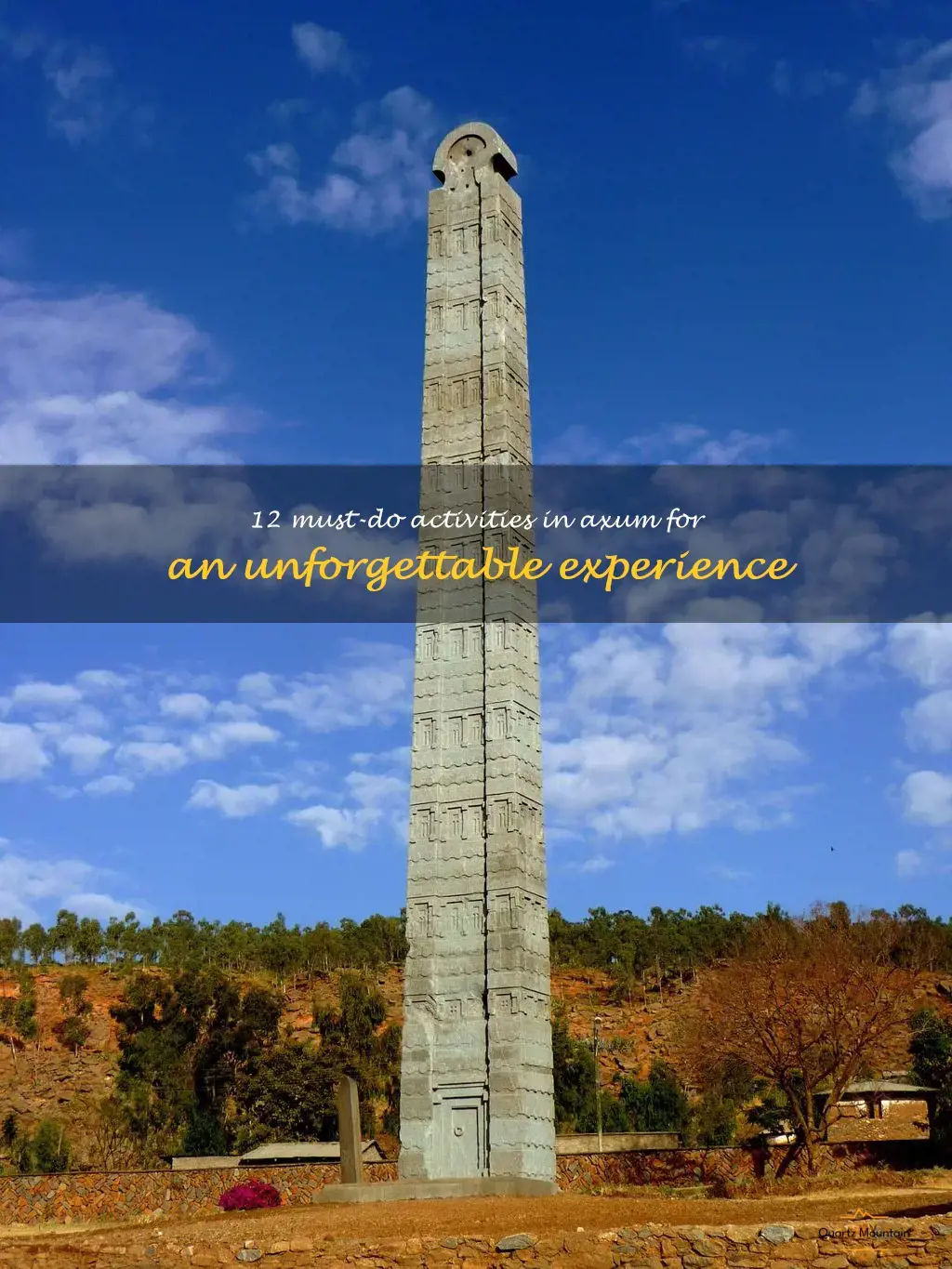
Welcome to Axum, a city steeped in ancient history and cultural significance. Axum's importance to Ethiopia, and indeed the world, cannot be overstated. This city was once the capital of the powerful Axumite Empire, which controlled much of the Horn of Africa. Today, Axum is a fascinating destination that offers a plethora of must-do activities for visitors. From exploring ancient ruins and temples to learning about local traditions and savoring delicious food, this historic city is sure to leave a lasting impression on all who visit. Here are 12 must-do activities in Axum for an unforgettable experience.
What You'll Learn
- Visit the UNESCO World Heritage Site of the Stelae Park
- Explore the ancient ruins of the Queen of Sheba's Palace
- Marvel at the giant granite obelisks of Axum
- Discover Ethiopia's Christian roots at the Church of Our Lady Mary of Zion
- Sample traditional Ethiopian food at the local markets
- Take a scenic walk around the Tigray Mountains
- Admire the intricate carvings of the Monastery of Debre Damo
- Learn about Axum's fascinating history at the Axumite Museum
- Watch local weaving and pottery making demonstrations
- Take a day trip to the nearby Yeha Temple archaeological site
- Visit the Tomb of King Kaleb
- Attend a traditional coffee ceremony with locals

Visit the UNESCO World Heritage Site of the Stelae Park
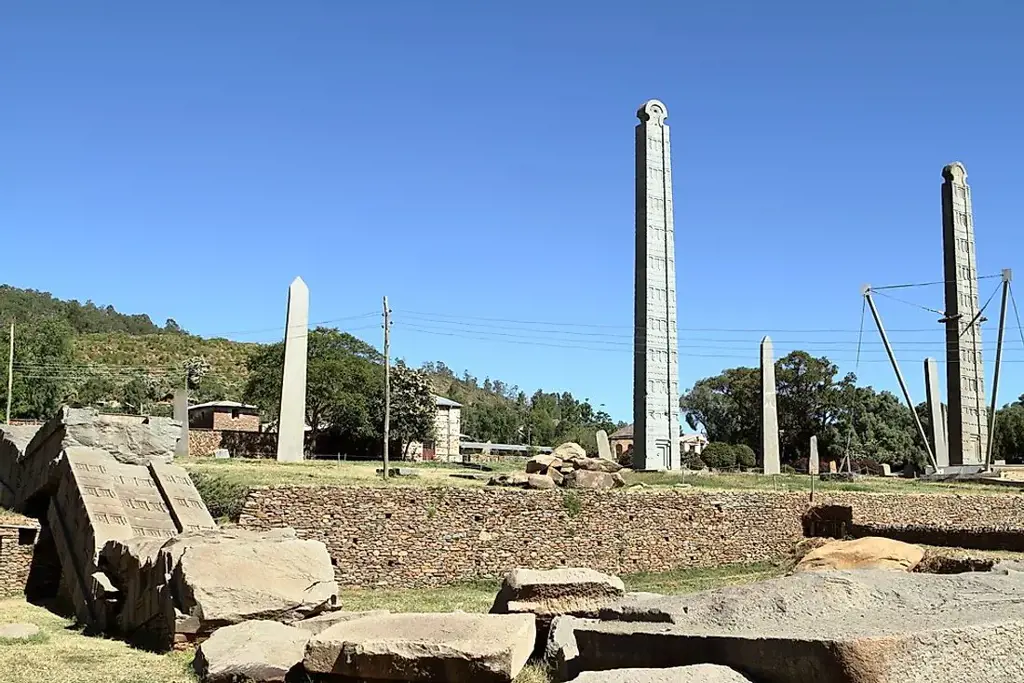
Axum, located in the northern part of Ethiopia, is a city steeped in ancient history and culture. Once the capital of the Axumite Kingdom, it is now a UNESCO World Heritage Site and a popular destination for tourists from around the world. One of the main attractions in Axum is the Stelae Park, which is home to some of the most impressive archaeological monuments in the world.
The Stelae Park is a collection of large, obelisk-like structures known as stelae. These stelae were created by the ancient Axumite civilization and are carved from a single piece of granite. The tallest of the stelae is over 33 meters tall and weighs over 500 tons, making it one of the largest monolithic structures in the world.
The stelae in the park are believed to date back to the 4th century AD and were erected as part of funerary monuments for ancient Axumite rulers. They are adorned with intricate carvings that depict stories of the Axumite civilization and its people. Some of the stelae have fallen over or been damaged over time, but many still stand upright and are an impressive sight to behold.
Visitors to the park can take a guided tour with a local guide who can provide insights into the history and culture of the Axumite civilization. The park also has a small museum that houses artifacts and exhibits that shed light on the ancient kingdom.
The Stelae Park is not just a testament to the magnificent engineering feats of the Axumite people, but it is also a reminder of the rich cultural heritage of Ethiopia. The park is a popular destination for tourists who want to learn more about the ancient civilization that once ruled this part of the world.
In conclusion, the Stelae Park in Axum is a must-visit destination for anyone interested in history, culture, and architecture. The stelae are a unique and fascinating sight that will leave visitors in awe of the ancient civilization that created them. This UNESCO World Heritage Site is a true testament to the ingenuity and creativity of the Axumite people and is a fitting tribute to their legacy.
14 Awesome Things to Do in Guadeloupe 2
You may want to see also

Explore the ancient ruins of the Queen of Sheba's Palace
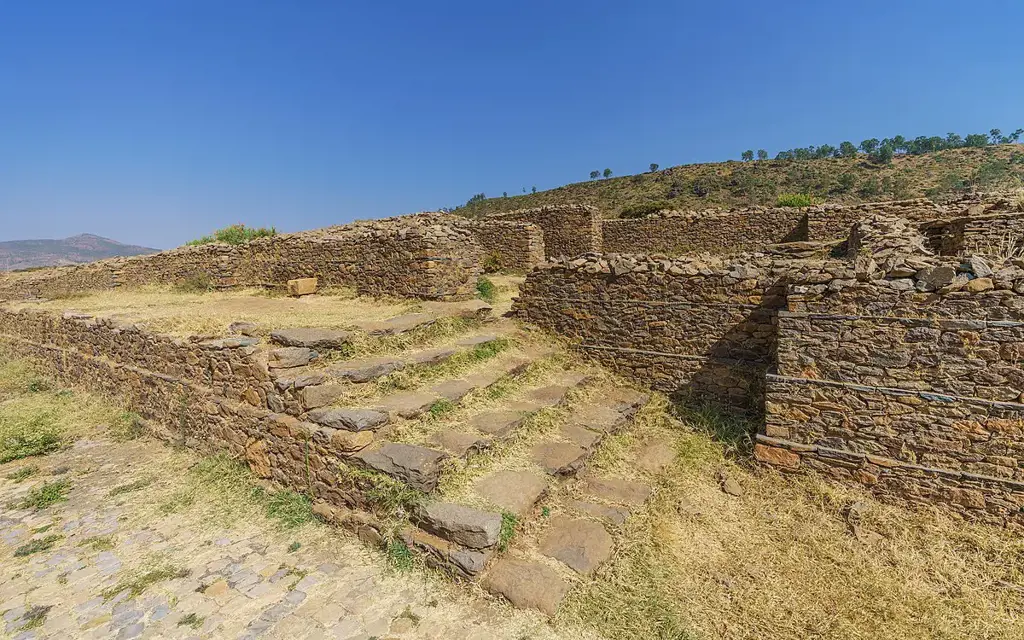
Located in northern Ethiopia, Axum is a historic city known for its remarkable ruins and treasures of ancient Ethiopia. It was once the capital of the Axumite Kingdom, a powerful civilization that ruled the region for over a thousand years. One of the most visited sites in Axum is the ancient palace of the Queen of Sheba, which is an iconic attraction that attracts visitors from all over the world.
According to folklore and legends, the Queen of Sheba, famous in the Bible and the Quran, traveled to Israel to meet King Solomon and returned to Axum with his son, Menelik I. Menelik established the Solomonic Dynasty which ruled Ethiopia for over 3,000 years. The Palace of the Queen of Sheba is believed to be a testament to the regal power that this civilization once held.
The palace ruins can be found in the center of the city and are part of the larger Axumite archeological site. The ruins are significant proof of the great architectural prowess that existed in ancient Ethiopia. The Palace of the Queen of Sheba was built with beautifully polished stone, in contrast to the other stone structures made with rougher stones, believed to be built around the 1st century AD.
The palace's multi-layered walls and intricate carvings suggest a lavish lifestyle, which was characteristic of the time. As you explore the palace, you will come across the remnants of pillow-shaped pillars used as beds, the walk-in baths, and the faces that have been carved onto the columns.
Apart from the Palace of the Queen of Sheba, other attractions within the Axumite archeological site include the Church of St. Mary of Zion, which is famous for housing the Ark of the Covenant. The Obelisks of Axum, which are tall and stately and are believed to have been erected over 1700 years ago, also provide a spectacular view.
In conclusion, the Palace of the Queen of Sheba remains a remarkable attraction that provides a glimpse into the rich history of the Axumite Kingdom. A visit to this historic site is a must for anyone looking to explore and learn more about the ancient civilization that once thrived in Ethiopia.
14 Fun Things to Do in Medford, Oregon
You may want to see also

Marvel at the giant granite obelisks of Axum
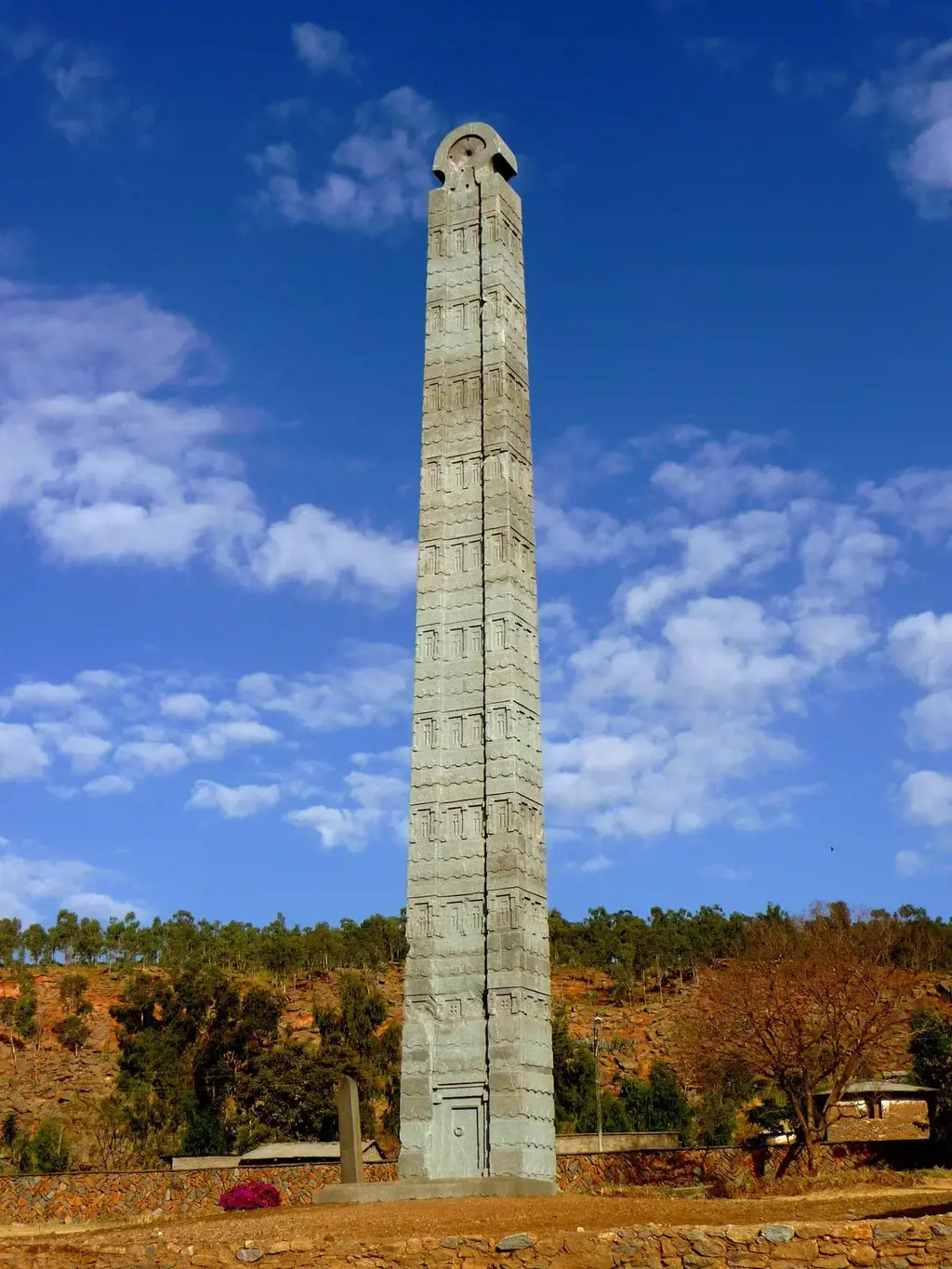
Located in the northern part of Ethiopia, the small town of Axum has an incredibly rich history that dates back to the ancient times when it was a powerful capital city of the Aksumite Empire. One of the most remarkable attractions in Axum are the giant granite obelisks, which are considered to be among the largest of their kind in the world, and stand as a testimony to Axum's ancient power and glory.
The obelisks of Axum were carved from a single piece of granite using primitive tools, and were erected in the city square during the 4th and 5th centuries AD. The tallest obelisk which is now fallen and broken into pieces is estimated to have stood at over 33 meters tall, dwarfing the surrounding buildings and aweing visitors with its sheer size. The Obelisk of Axum, also known as the King Ezana's Stele stands at a height of 23 meters and is the largest standing obelisk in the world.
The obelisks of Axum are not only significant in terms of their size, but also for the messages they convey. Each obelisk is intricately decorated with engravings and inscriptions that narrate the events of the Aksumite Empire. The inscriptions found on the obelisks include detailed accounts of famous battles, religious stories, and the life and achievements of the Aksumite kings.
The obelisks' unique granite materials and intricate sculptures have attracted the attention of scholars and tourists alike, and have cemented Axum's position as a World Heritage Site. For anyone interested in ancient history, the Obelisks of Axum are not to be missed.
In conclusion, visiting Axum offers an unparalleled opportunity to marvel at these impressive ancient monoliths. They are a testament to the engineering and artistic skills of the Aksumite people and offer unique insights into the history of Ethiopia. A visit to the town of Axum and the Obelisks should definitely be on the itinerary of anyone interested in exploring the rich history of the Horn of Africa.
13 Fun Activities in Buffalo NY for Memorial Day Weekend
You may want to see also

Discover Ethiopia's Christian roots at the Church of Our Lady Mary of Zion
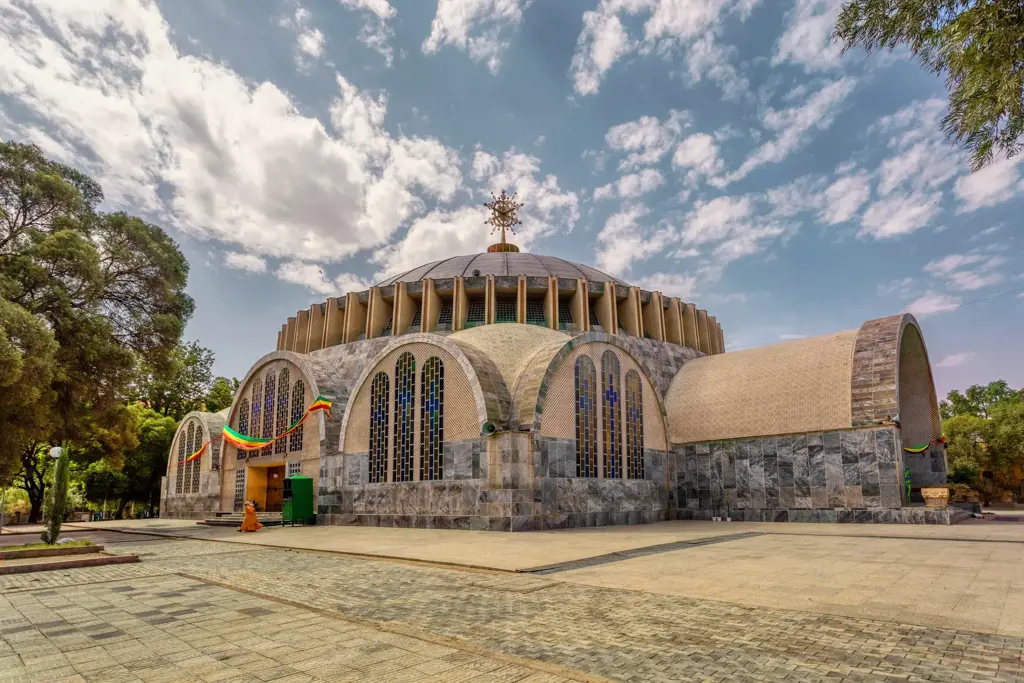
| Characteristic | Description |
|---|---|
| Name | Axum Tsion St. Mary |
| Type | Orthodox church in Axum, Ethiopia |
| Rating / Review count | 4.5 / 206 |
| Address | 4PJ9+5RH, Aksum, Ethiopia |
| Phone | +251 91 123 5044 |
The ancient Ethiopian city of Axum is steeped in history, culture, and religion. Located in the Tigray region of Ethiopia, Axum was once a powerful kingdom and an important trading center between Africa and the rest of the world. It is also the birthplace of Ethiopian Christianity, which has survived for over 1,600 years.
One of the most significant landmarks in Axum is the Church of Our Lady Mary of Zion. Tradition holds that it is the resting place of the Ark of the Covenant, which is believed to contain the Ten Commandments that were given to Moses by God on Mount Sinai. The church is also the holiest site in Ethiopia and a pilgrimage destination for Ethiopian Orthodox Christians.
The Church of Our Lady Mary of Zion has a rich history that dates back to the 4th century. It was built by the first Christian ruler of Axum, King Ezana, who converted to Christianity under the influence of Frumentius, a Syrian missionary. The original church was destroyed by Muslim invaders in the 16th century and was rebuilt in the 17th century by Emperor Fasilides.
The church is an impressive structure with stone walls, beautiful frescoes, and a rooftop covered in gold. It is believed to house several important artifacts, including the Ark of the Covenant, the crown of King Haile Selassie, and the original cross that was used to convert the Ethiopian king to Christianity. Visitors are not allowed inside the church, but they can peek through the gate and admire the church's exterior.
The Church of Our Lady Mary of Zion is not only a religious site but also an important cultural landmark. It symbolizes the endurance and resilience of Ethiopian Christianity, which has survived despite centuries of persecution and isolation. It is also a testament to the rich history and heritage of Ethiopia, which has a unique blend of African and Middle Eastern influences.
Visiting the Church of Our Lady Mary of Zion is an unforgettable experience that offers a glimpse into Ethiopia's past and present. It is a reminder of the importance of preserving our cultural and religious heritage and of the power of faith to sustain us through difficult times. Whether you are a religious pilgrim or a curious traveler, the Church of Our Lady Mary of Zion is a must-see destination in Axum.
12 Fun Things to Do in Seneca, SC
You may want to see also

Sample traditional Ethiopian food at the local markets

| Characteristic | Description |
|---|---|
| Name | Lucy Traditional Restaurant |
| Type | Ethiopian restaurant |
| Rating / Review count | 3.1 / 9 |
| Address | 4PGM+5H8, Aksum, Ethiopia |
| Phone | +251 91 476 8399 |
| Hours | Friday_patriots_victory_day - opens at 6 AM and closes at 10 PM Saturday - opens at 6 AM and closes at 10 PM Sunday - opens at 6 AM and closes at 10 PM Monday - opens at 6 AM and closes at 10 PM Tuesday - opens at 6 AM and closes at 10 PM Wednesday - opens at 6 AM and closes at 10 PM Thursday - opens at 6 AM and closes at 10 PM |
Axum, Ethiopia is a city steeped in history and culture, and one of the best ways to experience it is through its cuisine. The local markets are the perfect place to sample traditional Ethiopian food, which is renowned for its unique blend of flavors and cooking techniques.
One of the most famous Ethiopian dishes is injera, a soft, spongy flatbread made from teff flour. It is the staple food of the country and is used as a utensil to scoop up stews and other dishes. Injera is often served with wat, a spicy stew made with meat or vegetables that is simmered in a blend of spices and served in a communal dish. At the local markets in Axum, you can find vendors selling freshly made injera and a variety of wats that are both delicious and affordable.
Another Ethiopian specialty that you can find at the local markets in Axum is kitfo, a dish made from finely minced raw beef that is marinated in spices and served with injera. Although it may sound unappetizing to some, kitfo is a popular dish in Ethiopia and a must-try for adventurous foodies.
For those with a sweet tooth, Ethiopian desserts are a must-try. One of the most popular is halva, a tahini-based dessert that is sweetened with honey and flavored with spices such as cardamom and cinnamon. At the local markets in Axum, you can find vendors selling fresh halva that is both creamy and indulgent.
Finally, no visit to a local market in Ethiopia is complete without trying coffee, which is a passion in the country. Ethiopian coffee is famous for its rich, fruity flavor and is often prepared using traditional methods like roasting the beans over an open flame and brewing in a jebena, a clay pot with a narrow spout. At the local markets in Axum, you can find vendors selling freshly roasted coffee and offering traditional coffee ceremonies that are a must-see for coffee lovers.
In conclusion, if you want to experience the true flavors of Ethiopia, a visit to the local markets in Axum is a must! Whether you are a meat lover, vegetarian, or dessert aficionado, you are sure to find something that will tantalize your taste buds and leave a lasting impression.
12 Fun Activities to Experience in Owego NY
You may want to see also

Take a scenic walk around the Tigray Mountains

Axum, the ancient capital city of the Kingdom of Axum, is a UNESCO World Heritage site located in the northern part of Ethiopia. The city is known for its rich cultural and historical heritage, including the towering obelisks and several ancient ruins. One of the best ways to explore the beauty and charm of Axum is by taking a scenic walk around the Tigray Mountains.
The Tigray Mountains, also known as the Raya Mountains, are a range of highlands located in the northern part of Ethiopia. The mountains offer breathtaking views of the surrounding areas and are home to several important historical and cultural sites. Walking through the mountains is an opportunity to explore the rich natural beauty of Ethiopia and discover some of its most treasured landmarks.
The Tigray Mountains can be easily accessed from Axum, which is situated at the foothills of the mountain range. The walking trails through the mountains are well maintained, and visitors can choose from various routes that cater to their level of fitness and experience. The trails are marked and offer ample opportunities to rest, take in the stunning views, and learn more about the history and culture of the area.
One of the highlights of the walk is the Tigray Rock-Hewn Churches, a collection of ancient churches carved into the rocky cliffs of the mountains. These churches have been in use since the 4th century and are considered some of the most important religious sites in Ethiopia. The churches are an architectural marvel, and their intricate design and decoration are a testament to the skill and creativity of the ancient builders.
Another attraction in the Tigray Mountains is the spectacular Tigray Gheralta cluster, a collection of towering rock formations that rise out of the desert-like landscape. These majestic cliffs have been sculpted into jaw-dropping shapes, and their beauty can be appreciated while hiking through the surrounding trails.
For wildlife enthusiasts, the Tigray Mountains are home to several endemic species, including the gelada baboons, Ethiopian wolves, and ibexes. It is an excellent opportunity to see these animals in their natural habitat.
In conclusion, a scenic walk around the Tigray Mountains is an excellent way to explore Axum's natural beauty and rich cultural heritage. The mountains are a must-visit destination for any traveler interested in history, architecture, nature, and adventure. With its stunning views, ancient sites, and fascinating wildlife, the Tigray Mountains are sure to leave a lasting impression on all who visit.
13 Exciting Things to Do in Minden, LA
You may want to see also

Admire the intricate carvings of the Monastery of Debre Damo
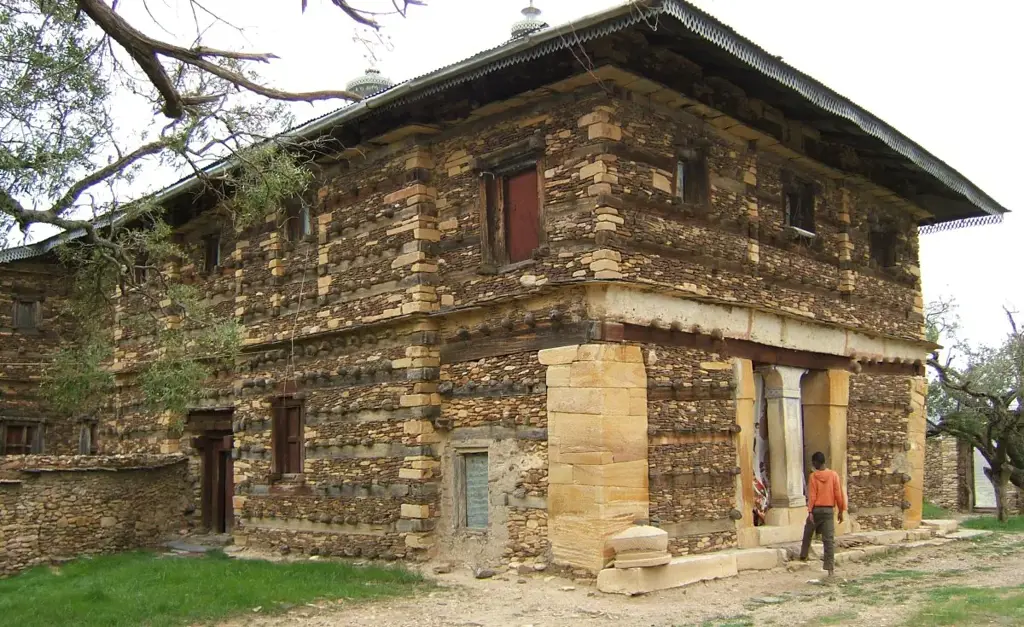
Axum, located in northern Ethiopia, is a city rich in history and culture. One of the must-visit destinations in Axum is the Monastery of Debre Damo, a stunning example of ancient Ethiopian architecture. The monastery is built on top of a cliff, and access to the building is only possible through a challenging climb using a rope and a wooden platform. However, the view from the monastery is quite spectacular, and it is worth the effort to admire the intricate carvings that adorn the building's walls.
The Monastery of Debre Damo is one of the oldest monasteries in Ethiopia and is believed to have been founded in the 6th century by Abuna Aregawi, one of the Nine Saints of Ethiopia. The building's design is quite unique, featuring a circular shape and a central pillar that holds up the roof. The walls of the building are made of stone, and they are decorated with beautiful and intricate carvings and paintings that date back to the 15th century.
The carvings on the walls of the Monastery of Debre Damo depict scenes from the Bible and Ethiopian history, as well as images of birds, animals, and plants. Each carving is unique and tells a story, making a visit to the monastery an unforgettable experience. Visitors can learn about Ethiopian history and culture while admiring the incredible craftsmanship of the ancient Ethiopian artists who created these carvings.
The Monastery of Debre Damo is also an active monastic community, and visitors can see the monks going about their daily routines. Strict rules are imposed upon visitors, such as the requirement to remove shoes before entering the monastery and the prohibition on women entering the monastery. Visitors are also expected to dress modestly and behave respectfully while on the premises.
In conclusion, the Monastery of Debre Damo is a fascinating example of ancient Ethiopian architecture and art. The intricate carvings on the walls of the monastery are a testament to the skill and creativity of the ancient Ethiopian artists who created them. A visit to this incredible destination is an opportunity to learn about Ethiopian history and culture while admiring the beauty and craftsmanship of the Monastery of Debre Damo.
14 Fun Things to do in Franklin, Indiana
You may want to see also

Learn about Axum's fascinating history at the Axumite Museum
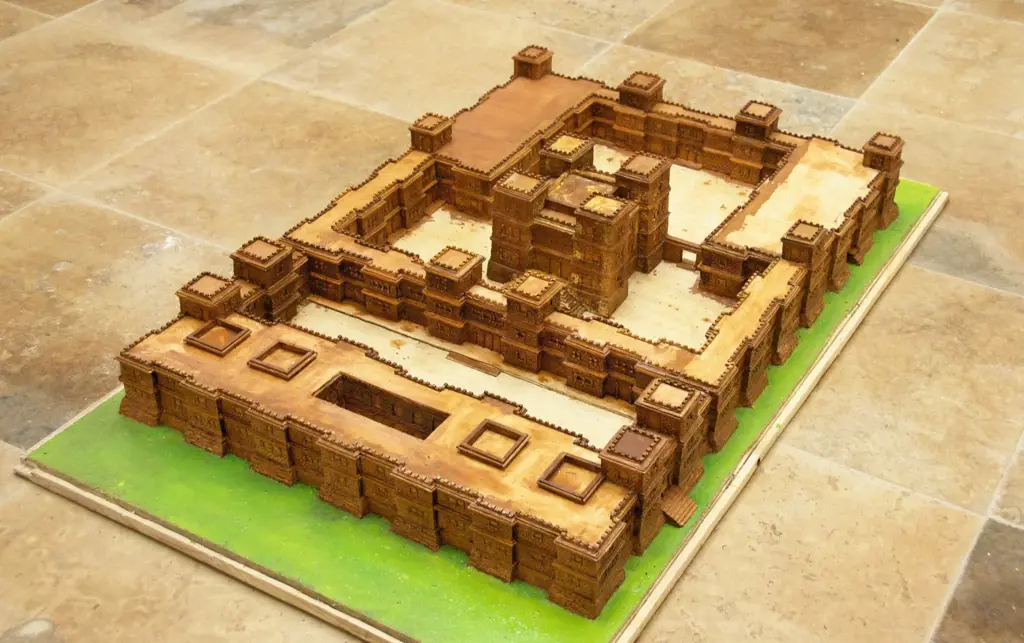
Axum, located in the northern part of Ethiopia, is one of the most ancient cities in the world. Once the capital of the country’s most powerful kingdom, Axum is now famous for its well-preserved archaeological remains and religious monuments. The Axumite Museum, located in the city, is a treasure trove of collections that provide visitors with a glimpse into the fascinating history of this ancient empire.
The Axumite Museum is a must-visit for anyone interested in history, architecture, and religion. It is home to a diverse range of artifacts dating back to the third century BC that tells the story of Axum's rise to power. The museum's collections include coins, metal weapons, jewelry, pottery, and stelae, which are tall obelisks that were erected in the 4th century AD to commemorate Axumite rulers.
One of the museum's most impressive exhibits is the Aksum Cross, which is believed to be the oldest Christian artifact in Africa. It is made of pure gold and is adorned with precious stones, and is thought to have belonged to one of the early Christian rulers of Axum. The museum also features a large collection of ancient Ethiopian manuscripts, including an illuminated Gospel from the 14th century.
The crowning glory of the museum is the Axumite Stelae Park, which is located outside the museum building. This is where visitors can see the largest stelae in Axum, and it is believed that there were once more than 100 of these structures in the city. The main obelisk measures 33 meters and is the tallest single stone structure in the world. Visitors can also see the Lion of Judah, a stone statue that symbolizes Ethiopia’s monarchy, and the ruins of the Queen of Sheba’s palace.
Axum's history is also closely linked with the legend of the Queen of Sheba, who is believed to have ruled over a prosperous kingdom in the 10th century BC. The story of her visit to King Solomon in Jerusalem is narrated in the Bible, and traces of her palace and palace baths can still be found in Axum.
Axum's ancient churches are also a testament to the city's rich history. The Church of St. Mary of Zion, located in the city center, is the holiest site in Ethiopia and is believed to house the original Ark of the Covenant. The church's central chapel is not open to visitors, but the outer courtyard and the adjacent museum, which showcases an impressive collection of artifacts, are accessible.
In conclusion, the Axumite Museum is a must-visit destination for anyone interested in exploring Ethiopia's ancient history. The museum's diverse collections and impressive exhibits provide a glimpse into the fascinating, multi-layered history of Axum. Visitors can explore the park and take in the majestic stelae, visit the Queen of Sheba's palace, and learn about the country's religious heritage at the Church of St. Mary of Zion. A visit to Axum and the Axumite Museum is truly a once-in-a-lifetime experience.
12 Exciting Activities to Enjoy with Kids in Sharm El Sheikh
You may want to see also

Watch local weaving and pottery making demonstrations
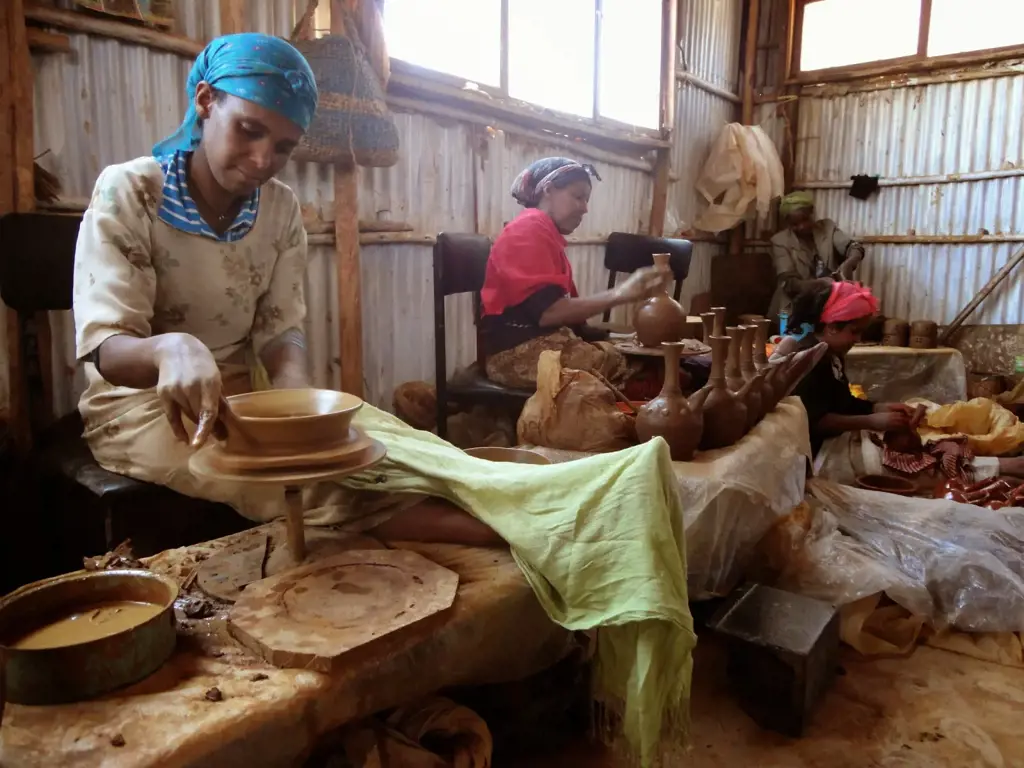
Axum, a city in northern Ethiopia, is well-known for its rich history and ancient civilization. The city was once the capital of the Axumite Empire, which was one of the most important ancient empires in Africa. Today, Axum is a major tourist destination, attracting people from all around the world who are keen to discover more about the city’s ancient civilization.
One of the most fascinating attractions in Axum is the opportunity to watch local weaving and pottery making demonstrations. Visitors can witness the skills of local artisans and learn more about the traditional crafts that have been passed down through generations. The weaving and pottery making skills are deeply ingrained in the local community, and visiting these demonstrations is a great way to experience the local culture.
The weaving demonstrations showcase some of the most beautiful and intricate textiles in the world. Local weavers use traditional techniques to create stunning textiles, such as shawls, skirts, and wraps. The textiles are made from cotton, silk, and wool, and feature intricate designs and patterns. Visitors can watch as the weavers use handlooms to create the textiles, and they can even purchase some of the fabrics to take home as a souvenir.
Pottery making is another traditional craft that is still practiced in Axum today. The local potters create beautiful ceramics using traditional techniques and tools. Visitors can watch as the potters mold and shape the clay by hand, forming pots, dishes, and other ceramic items. The potters use a variety of techniques to decorate their ceramics, including etching, carving, and painting. Visitors can purchase some of the ceramics to take home as a unique and beautiful souvenir.
Overall, visiting the weaving and pottery demonstrations in Axum is a great way to learn more about the local culture and discover the ancient skills that are still practiced today. By watching local artisans at work, visitors can gain a deeper appreciation for the craft and skill that goes into creating traditional textiles and ceramics.
10 Fun Ideas for Exploring Goodland, KS
You may want to see also

Take a day trip to the nearby Yeha Temple archaeological site
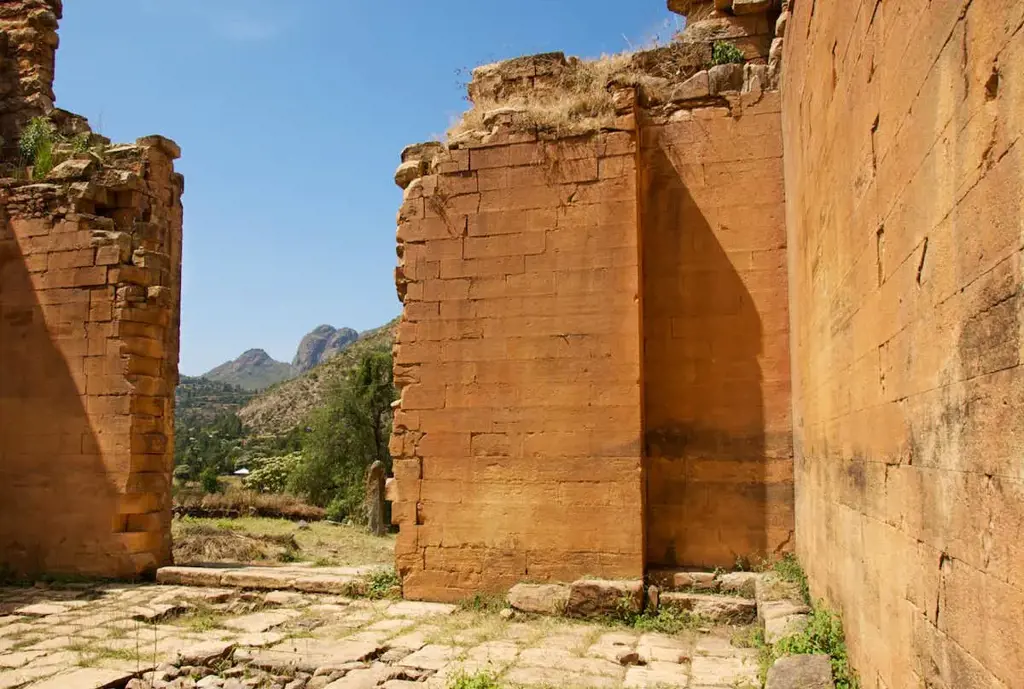
Axum is a city located in the Tigray Region of Ethiopia. It is a historically significant city that was once the capital of the Axumite Kingdom. The city is famous for its ancient monuments and archaeological sites. One of the most important sites near Axum is the Yeha temple, which is located about 50 kilometers northeast of the city.
The Yeha Temple was built in the 7th century BC and is one of the oldest standing buildings in Ethiopia. It is believed to have been a center of worship for the moon god and was later converted into a Christian church. The temple is made of stone and features significant architectural and artistic designs. The carvings on the walls and the doors of the temple are believed to be some of the earliest representations of the Sabean language, which was the language of the ancient Axumite Kingdom.
A day trip to the Yeha Temple is an excellent way to immerse oneself in Ethiopia's rich history and culture. Visitors can start their day early and drive to the temple, which is located in a rural area. The drive is scenic and showcases the beauty of the Ethiopian countryside. Visitors can also stop at various villages along the way and interact with locals to learn about their way of life.
Upon arrival at the temple, visitors will be greeted by a guide who will take them through the site. The tour will provide insights into the temple's history and architecture, as well as its religious significance. Visitors can also explore the remains of the ancient town that once surrounded the temple and see the ruins of other important structures, such as the palace of the queen of Sheba.
The Yeha Temple is also an excellent place for photography enthusiasts. The stone structure is set against a picturesque backdrop of hills and mountains. Visitors can capture stunning images of the temple and its surroundings and create lasting memories of their visit.
Overall, a day trip to the Yeha Temple in Axum is an enriching experience that provides visitors with a glimpse into Ethiopia's rich cultural heritage. The temple's ancient architecture and impressive carvings are a testament to its significance in the region's history. The trip is well worth it for those interested in history and culture and seeking an adventure off the beaten path in Ethiopia.
13 Fun Things to Do in Springfield or Beyond!
You may want to see also

Visit the Tomb of King Kaleb
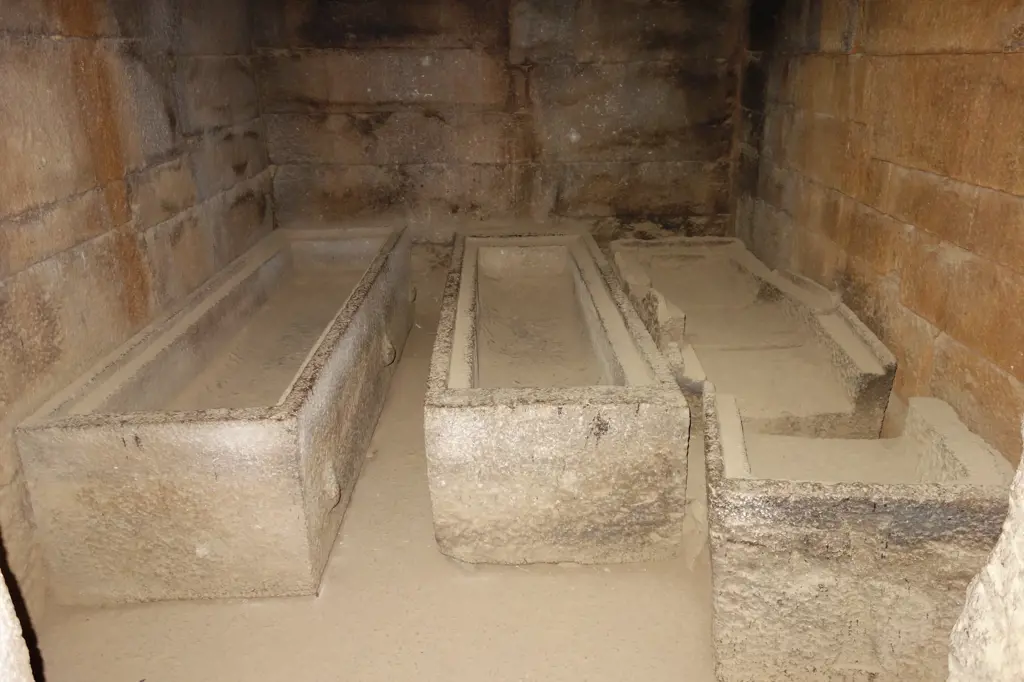
Axum, located in northern Ethiopia, is an ancient city that was once the capital of the Axumite Kingdom. The Axumite Kingdom was a powerful civilization that controlled large parts of East Africa and the Red Sea region from roughly 200 BC to 700 AD. One of the most important figures in the history of the Axumite Kingdom was King Kaleb, who ruled from 518 to 527 AD. Today, visitors to Axum can visit the tomb of King Kaleb, one of the city's most important historical sites.
The Tomb of King Kaleb is located within the Axumite archaeological site, which also includes the ruins of ancient temples, palaces, and other structures. The tomb is believed to be the final resting place of King Kaleb, who was known for his strong leadership, military conquests, and support of Christianity. According to legend, the tomb was constructed over 1,500 years ago by the king's loyal followers, who were determined to honor their leader and ensure his eternal rest.
Visitors to the Tomb of King Kaleb can expect to see a simple stone structure with a small entrance and no adornments. The tomb, like many ancient structures in Axum, is made from large blocks of stone that were carefully fitted together to create a sturdy and durable structure. While the tomb itself may be unremarkable, the historical significance of King Kaleb and his reign can be felt throughout the entire Axumite site.
In addition to the Tomb of King Kaleb, visitors to Axum can also explore other historical sites, such as the Stelae Park, which features towering stone obelisks that were erected by the Axumite Kingdom over 2,000 years ago. The city is also home to the Church of Our Lady Mary of Zion, which is said to house the Ark of the Covenant, one of the most important religious artifacts in the world.
Overall, a visit to the Tomb of King Kaleb in Axum is a unique opportunity to explore one of Africa's most important historical sites. As visitors explore this ancient city, they will be transported back in time to a period when the Axumite Kingdom was at the height of its power and influence. Whether you are a history buff, a religious pilgrim, or simply a curious traveler, the Tomb of King Kaleb is a must-see destination that should not be missed.
12 Fun Things to Do in Sapphire, North Carolina
You may want to see also

Attend a traditional coffee ceremony with locals

Axum, a city located in northern Ethiopia, is not only known for its archaeological sites and religious history but also its rich cultural traditions. One of the most fascinating traditions of Axum is the coffee ceremony. Attending a traditional coffee ceremony with locals is an exceptional experience and a must-do when visiting Axum.
The coffee ceremony in Axum involves a group of people gathering around a special coffee area that is decorated with flowers and incense. The coffee ceremony involves the roasting, grinding, brewing, and serving of coffee to guests in a traditional way. The ceremony is usually led by a female member of the household and is a symbol of hospitality and friendship.
The coffee beans are washed, roasted over hot coals, and then ground using a mortar and pestle. The ground coffee is then boiled in a coffee pot and served in small traditional coffee cups, which are known as ‘cini’. The coffee is usually served with a typical Ethiopian snack such as popcorn or roasted barley.
The ceremony is not only about the coffee but also about the community. It is a chance for people to socialize, talk, and share stories. It is also an opportunity to learn about the Axum culture and the history of coffee in Ethiopia.
Coffee is an integral part of Ethiopian culture and has been for centuries. According to legend, coffee was discovered in Ethiopia by a goat herder named Kaldi, who noticed that his goats became energized after eating the red berries of a particular tree. Kaldi shared his discovery with local monks, who used the berries to make a drink that helped them stay awake during long prayer sessions.
Today, Ethiopia is one of the largest coffee producers in the world, and Axum is no exception. Coffee is grown in the surrounding hills and is a vital part of the local economy.
In conclusion, attending a traditional coffee ceremony with locals is an extraordinary experience that visitors to Axum should not miss. It is a chance to learn about Ethiopian culture, the history of coffee, and the community. The ceremony represents the warm and welcoming nature of the Ethiopian people and will leave visitors with unforgettable memories.
14 Fun Activities to Experience in Sacramento This Fourth of July Weekend
You may want to see also
Frequently asked questions
Answer: The Axum Obelisks, the ruins of the Queen of Sheba's Palace, and the Axum Stelae Field are all must-see historical sites in Axum.
Answer: No, the Ark of the Covenant is said to be housed at the Church of Our Lady Mary of Zion in Axum, but it is not open to the public or foreigners.
Answer: Visitors can go hiking in the nearby Simien Mountains, explore the Tigray rock churches, or take a boat ride on Lake Tana.
Answer: The best time to visit Axum is during the dry season from October to March, when the weather is cooler and there is less chance of rainfall. However, the peak tourist season is from December to February, so prices may be higher during this time.








5 Comments
Safia Livingston
Rajan Bender
Jose Ramos
AuthorJessica Johnston
Kryms Kaya
Author